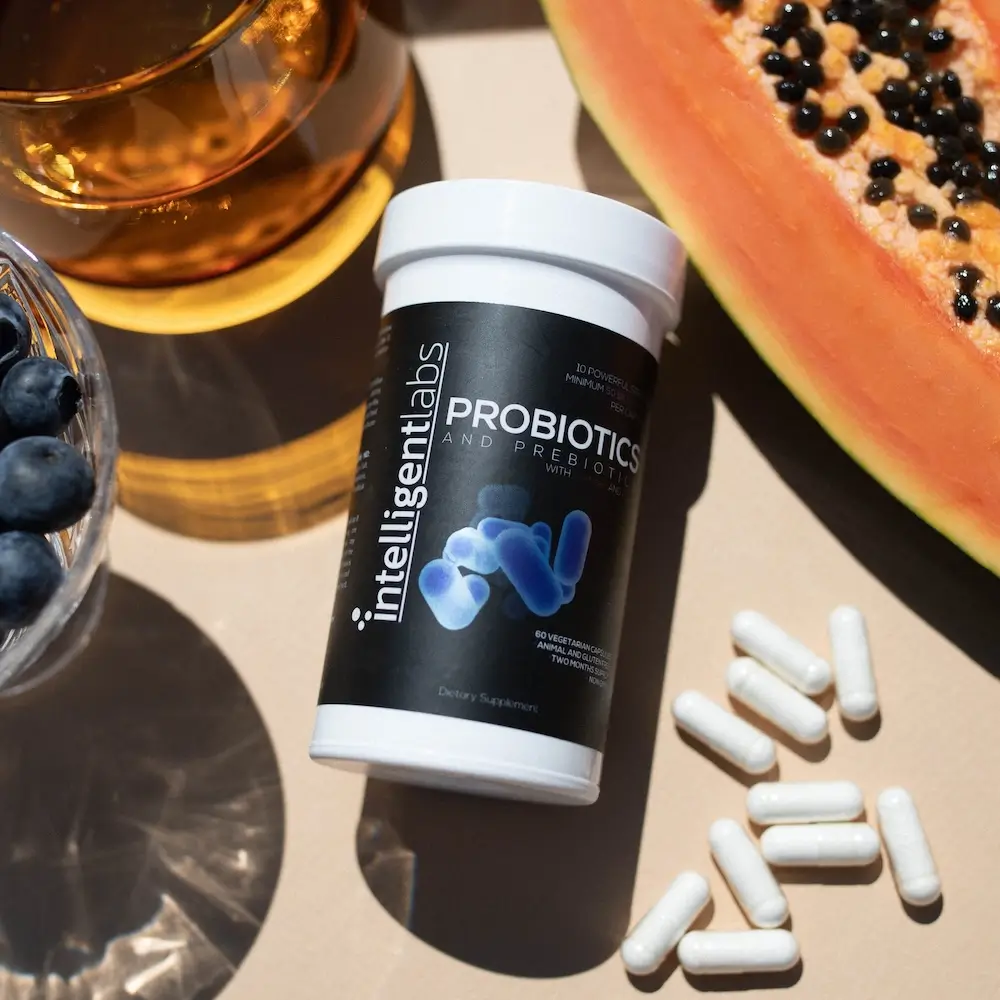A breastfeeding mother needs to be mindful of anything she takes or consumes. Harmful ingredients from foods, supplements, and medications may make their way to breastmilk and pose some risks to the infant. Are probiotics supplements one of them though? Can moms safely take probiotics while breastfeeding? Let’s find out!
Table of Contents
What are probiotics?
Probiotics are live cultures of good and beneficial bacteria. They are found primarily in the gut, but also in other parts of the body. They’re naturally part of the gut microbiome, which is home to trillions of microorganisms, such as bacteria, viruses, and fungi.1
When are babies first exposed to probiotics?
It was previously thought that the womb is a sterile environment and that unborn babies aren’t exposed to microbes within the womb. But new studies have found the presence of microbes in the amniotic fluid, umbilical blood cord, and placenta. This suggests the presence of a prenatal microbiome. 2
Outside of the womb, however, babies born via vaginal delivery have a distinct advantage over C-section babies. They are exposed to protective bacteria when they pass through their mother’s vaginal canal. These newborns also typically have a more robust immune system compared to C-section babies.3
On the other hand, the guts of C-section babies are primarily colonized by potentially pathogenic bacteria. These “bad” strains, i.e. Staphylococcus, are typically present on human skin and hospital surfaces. C-section babies have a higher risk of allergies, asthma, gastroenteritis, Celiac disease, and even type 1 diabetes. 4
Can probiotics be passed through breastmilk?
Yes, probiotics have been isolated from human breastmilk, meaning they make it all the way from the mother’s gut to the breastmilk. How? Well, these tiny microorganisms use the entero-mammary pathway to cross the intestine and reach the mammary glands. 5
Is it okay for moms to take probiotics while breastfeeding?
Yes, healthy breastfeeding moms should be able to take probiotic supplements with no issues.

After all, breastmilk is a significant source of probiotics for nursing infants. Examples of probiotic strains found in breastmilk are Lactobacillus gasseri, L. fermentum, and L. salivarius. 6
In addition to probiotics, prebiotics is also naturally present in breastmilk. Prebiotics act as food for probiotics, allowing them to multiply and grow in numbers. This probiotics + prebiotics combo contributes to a more robust immune system in breastfed infants. 7
Note: Please speak with your primary care physician before taking probiotics, or any supplements, for that matter.
How do probiotics in breastmilk help babies?
Now that we know probiotics are one of the “ingredients” in breastmilk, here’s how they help babies:
- It may promote the growth of good bacteria population in the gut, such as the Bifidobacteria strain (7)
- It may offer better immunity and protection against pediatric asthma 8
- When applied topically, breastmilk may help clear up eczema in infants 9
- It may contribute to an increase in lung volume and function 10
Breastfed kids also turn out to be more resilient against stress-related anxiety. This includes parental separation or divorce.11
Do probiotics offer any benefits to breastfeeding moms?
Studies show that probiotics found in breastmilk may help treat infectious mastitis. Mastitis is an inflammation of the mammary glands, which commonly occurs within the first 3 months of breastfeeding. It’s a painful condition typically treated with painkillers and antibiotics. (5)
Additionally, a New Zealand study showed that women who took probiotics during and after pregnancy had significantly lower depression and anxiety after giving birth.12
We’ve written a comprehensive guide on the health benefits of taking probiotics here. But to give you an idea, here are some of the main benefits a breastfeeding mom may find helpful:
- Probiotics may promote optimal gastrointestinal health
- May offer respiratory health benefits
- May improve skin health
- These good microbes may help fight inflammation
- Probiotics may help with weight loss
- Helps improve sleep quality
- May boost your overall immunity
So, what’s the best probiotic supplement for breastfeeding moms?
Not all probiotics are created equal. To reap the many benefits of probiotics, it’s important to make the right choice. We suggest you check out our 50 Billion CFU Adult Probiotics and Prebiotics.
Our Adult Probiotics contains 10 patented acid and bile-resistant probiotic strains. It also contains 2 types of prebiotics – Sunfiber® (made from guar fiber) and Fructooligosaccharides (FOS).
Each capsule is overfilled to 150 Billion CFU at the time of manufacture. And we use active packaging technology to ensure there are at least 50 Billion CFU within the 2-year shelf life. Lastly, each bottle contains 60 capsules (making it last for 2 months), so it’s excellent value for your money, too!

Now, those familiar with our products may be wondering if it’s okay to use our Women’s Probiotics & Prebiotics instead?
Unfortunately, there aren’t enough studies to support the safe use of D-mannose for breastfeeding women, so we cannot recommend it at this point. 13
D-mannose is one of the ingredients in our Women’s Probiotics, along with 4 strains of probiotics, 2 types of prebiotics, and cranberry juice powder. This product is formulated to help support women’s gut and urinary system health. Many customers have reported that our Women’s Probiotics helped resolve their urinary tract infections and yeast infections, too.
What about fermented foods? Are they safe to eat when breastfeeding?
Fermented foods such as yogurt, pickles, kimchi, and miso are natural sources of probiotics. They are safe to eat while pregnant and breastfeeding, though you may need to consume them in moderation, especially the spicy ones. That said, fermented foods may protect babies against infantile atopic dermatitis.14
What are some possible side effects of taking probiotics while breastfeeding?
Probiotics are generally safe to take, but gas, bloating, and diarrhea may occur during the first few days of intake. During this time, rebalancing is gradually occurring in the gut microbiome, i.e. the probiotics are working as they should!
Final thoughts
As you’ve learned in this article, there are plenty of upsides to taking probiotics while breastfeeding. These tiny microbes can do a world of wonders for both mother and child. Side effects, if any, are usually mild and resolve in a short time. For best results, take your probiotics with a meal for optimal absorption.
💬 Something on your mind? Share your thoughts in the comments. We love hearing from curious minds.
📩 And while you’re here, join our newsletter for more smart stuff (and secret perks)!
References:
- Thursby, Elizabeth, and Nathalie Juge. “Introduction to the human gut microbiota.” The Biochemical journal vol. 474,11 1823-1836. 16 May. 2017, doi:10.1042/BCJ20160510 ↩︎
- D’Argenio, Valeria. “The Prenatal Microbiome: A New Player for Human Health.” High-throughput vol. 7,4 38. 11 Dec. 2018, doi:10.3390/ht7040038 ↩︎
- “Vaginal Seeding: Procedure, Benefits, Risks & What to Expect.” Cleveland Clinic, my.clevelandclinic.org/health/treatments/22096-vaginal-seeding. ↩︎
- Neu, Josef, and Jona Rushing. “Cesarean versus vaginal delivery: long-term infant outcomes and the hygiene hypothesis.” Clinics in perinatology vol. 38,2 (2011): 321-31. doi:10.1016/j.clp.2011.03.008 ↩︎
- Jiménez, E et al. “Oral administration of Lactobacillus strains isolated from breast milk as an alternative for the treatment of infectious mastitis during lactation.” Applied and environmental microbiology vol. 74,15 (2008): 4650-5. doi:10.1128/AEM.02599-07 ↩︎
- Martín, Rocío et al. “Human milk is a source of lactic acid bacteria for the infant gut.” The Journal of pediatrics vol. 143,6 (2003): 754-8. doi:10.1016/j.jpeds.2003.09.028 ↩︎
- Moossavi, Shirin et al. “The Prebiotic and Probiotic Properties of Human Milk: Implications for Infant Immune Development and Pediatric Asthma.” Frontiers in pediatrics vol. 6 197. 24 Jul. 2018, doi:10.3389/fped.2018.00197 ↩︎
- Dogaru, Cristian M et al. “Breastfeeding and childhood asthma: systematic review and meta-analysis.” American journal of epidemiology vol. 179,10 (2014): 1153-67. doi:10.1093/aje/kwu072 ↩︎
- Witkowska-Zimny, Malgorzata et al. “Milk Therapy: Unexpected Uses for Human Breast Milk.” Nutrients vol. 11,5 944. 26 Apr. 2019, doi:10.3390/nu11050944 ↩︎
- Dogaru, Cristian M et al. “Breastfeeding, lung volumes and alveolar size at school-age.” BMJ open respiratory research vol. 2,1 e000081. 6 Jul. 2015, doi:10.1136/bmjresp-2015-000081 ↩︎
- Montgomery, S M et al. “Breast feeding and resilience against psychosocial stress.” Archives of disease in childhood vol. 91,12 (2006): 990-4. doi:10.1136/adc.2006.096826 ↩︎
- Slykerman, R F et al. “Effect of Lactobacillus rhamnosus HN001 in Pregnancy on Postpartum Symptoms of Depression and Anxiety: A Randomised Double-blind Placebo-controlled Trial.” EBioMedicine vol. 24 (2017): 159-165. doi:10.1016/j.ebiom.2017.09.013 ↩︎
- Miller, Kelli. “D-Mannose.” WebMD, WebMD, 12 Feb. 2013, www.webmd.com/vitamins-and-supplements/d-mannose-uses-and-risks. ↩︎
- Celik, Velat, et al. “Do Traditional Fermented Foods Protect against Infantile Atopic Dermatitis.” Pediatric Allergy and Immunology, 31 Mar. 2019, https://doi.org/10.1111/pai.13045. ↩︎




